2017 FORD F SERIES MOTORHOME AND COMMERCIAL CHASSIS radio
[x] Cancel search: radioPage 10 of 164
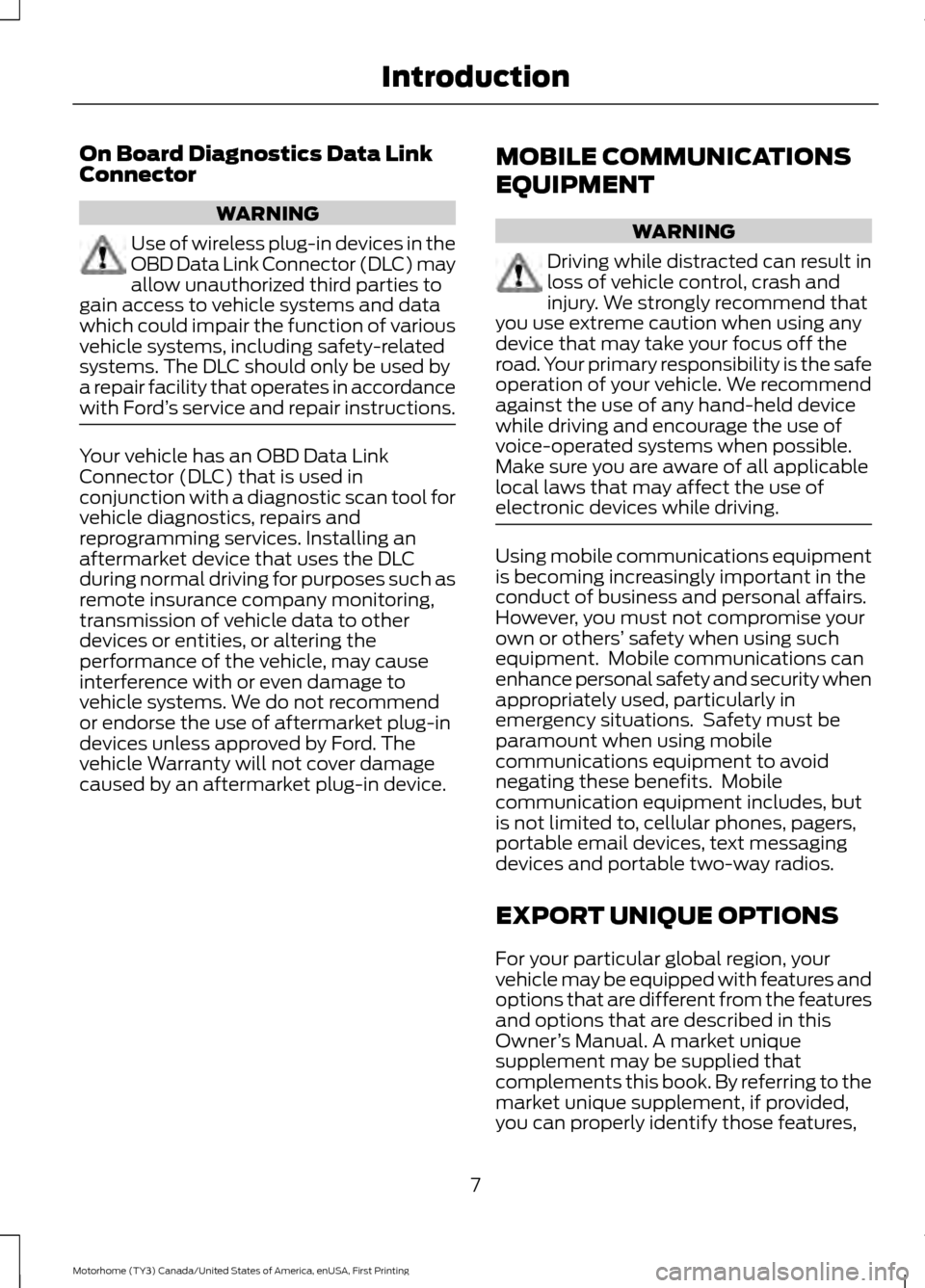
On Board Diagnostics Data Link
Connector
WARNING
Use of wireless plug-in devices in the
OBD Data Link Connector (DLC) may
allow unauthorized third parties to
gain access to vehicle systems and data
which could impair the function of various
vehicle systems, including safety-related
systems. The DLC should only be used by
a repair facility that operates in accordance
with Ford ’s service and repair instructions. Your vehicle has an OBD Data Link
Connector (DLC) that is used in
conjunction with a diagnostic scan tool for
vehicle diagnostics, repairs and
reprogramming services. Installing an
aftermarket device that uses the DLC
during normal driving for purposes such as
remote insurance company monitoring,
transmission of vehicle data to other
devices or entities, or altering the
performance of the vehicle, may cause
interference with or even damage to
vehicle systems. We do not recommend
or endorse the use of aftermarket plug-in
devices unless approved by Ford. The
vehicle Warranty will not cover damage
caused by an aftermarket plug-in device.
MOBILE COMMUNICATIONS
EQUIPMENT WARNING
Driving while distracted can result in
loss of vehicle control, crash and
injury. We strongly recommend that
you use extreme caution when using any
device that may take your focus off the
road. Your primary responsibility is the safe
operation of your vehicle. We recommend
against the use of any hand-held device
while driving and encourage the use of
voice-operated systems when possible.
Make sure you are aware of all applicable
local laws that may affect the use of
electronic devices while driving. Using mobile communications equipment
is becoming increasingly important in the
conduct of business and personal affairs.
However, you must not compromise your
own or others’
safety when using such
equipment. Mobile communications can
enhance personal safety and security when
appropriately used, particularly in
emergency situations. Safety must be
paramount when using mobile
communications equipment to avoid
negating these benefits. Mobile
communication equipment includes, but
is not limited to, cellular phones, pagers,
portable email devices, text messaging
devices and portable two-way radios.
EXPORT UNIQUE OPTIONS
For your particular global region, your
vehicle may be equipped with features and
options that are different from the features
and options that are described in this
Owner ’s Manual. A market unique
supplement may be supplied that
complements this book. By referring to the
market unique supplement, if provided,
you can properly identify those features,
7
Motorhome (TY3) Canada/United States of America, enUSA, First Printing Introduction
Page 26 of 164
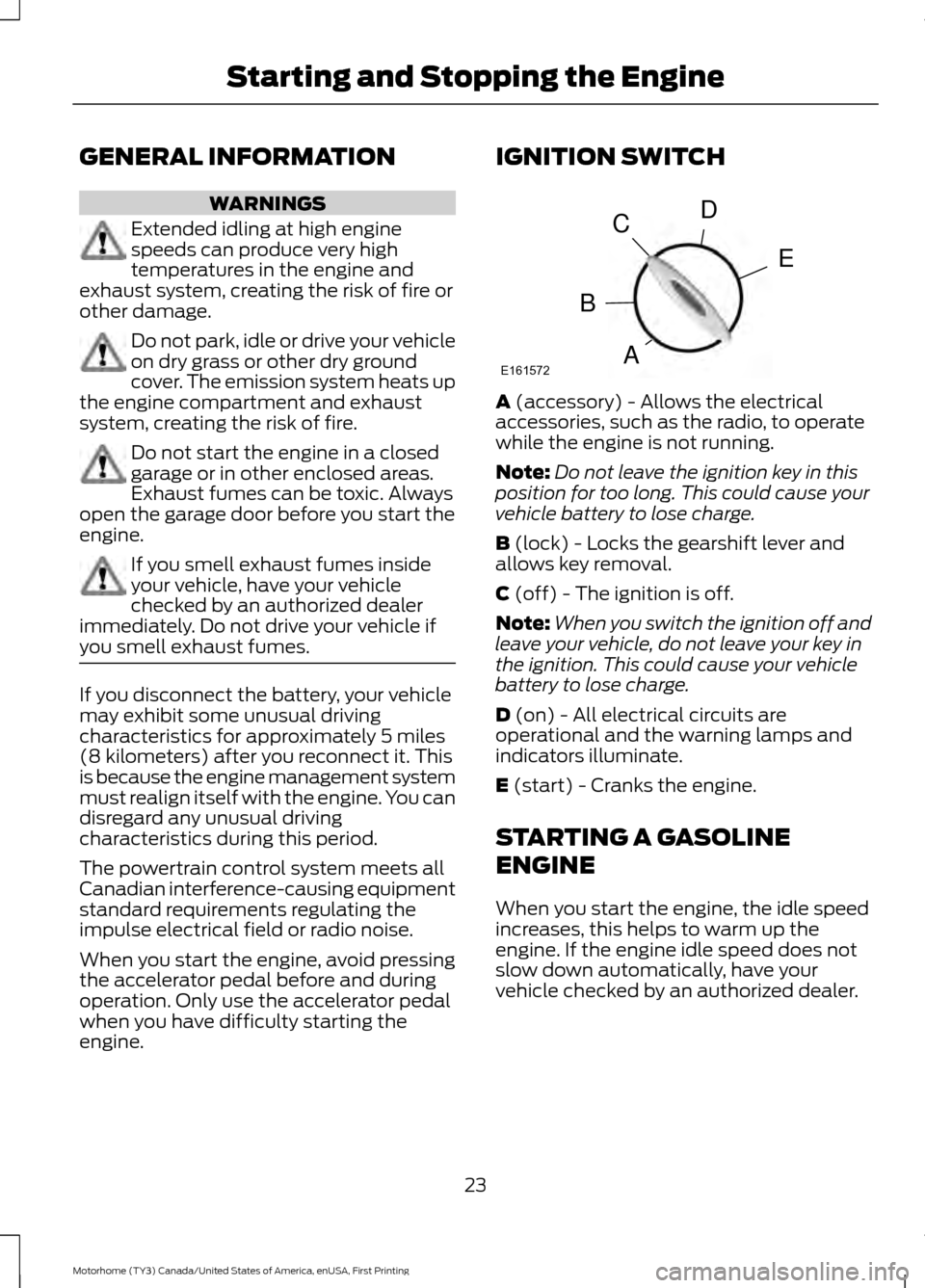
GENERAL INFORMATION
WARNINGS
Extended idling at high engine
speeds can produce very high
temperatures in the engine and
exhaust system, creating the risk of fire or
other damage. Do not park, idle or drive your vehicle
on dry grass or other dry ground
cover. The emission system heats up
the engine compartment and exhaust
system, creating the risk of fire. Do not start the engine in a closed
garage or in other enclosed areas.
Exhaust fumes can be toxic. Always
open the garage door before you start the
engine. If you smell exhaust fumes inside
your vehicle, have your vehicle
checked by an authorized dealer
immediately. Do not drive your vehicle if
you smell exhaust fumes. If you disconnect the battery, your vehicle
may exhibit some unusual driving
characteristics for approximately 5 miles
(8 kilometers) after you reconnect it. This
is because the engine management system
must realign itself with the engine. You can
disregard any unusual driving
characteristics during this period.
The powertrain control system meets all
Canadian interference-causing equipment
standard requirements regulating the
impulse electrical field or radio noise.
When you start the engine, avoid pressing
the accelerator pedal before and during
operation. Only use the accelerator pedal
when you have difficulty starting the
engine. IGNITION SWITCH
A (accessory) - Allows the electrical
accessories, such as the radio, to operate
while the engine is not running.
Note: Do not leave the ignition key in this
position for too long. This could cause your
vehicle battery to lose charge.
B
(lock) - Locks the gearshift lever and
allows key removal.
C
(off) - The ignition is off.
Note: When you switch the ignition off and
leave your vehicle, do not leave your key in
the ignition. This could cause your vehicle
battery to lose charge.
D
(on) - All electrical circuits are
operational and the warning lamps and
indicators illuminate.
E
(start) - Cranks the engine.
STARTING A GASOLINE
ENGINE
When you start the engine, the idle speed
increases, this helps to warm up the
engine. If the engine idle speed does not
slow down automatically, have your
vehicle checked by an authorized dealer.
23
Motorhome (TY3) Canada/United States of America, enUSA, First Printing Starting and Stopping the EngineE161572
D
E
C
B
A
Page 69 of 164
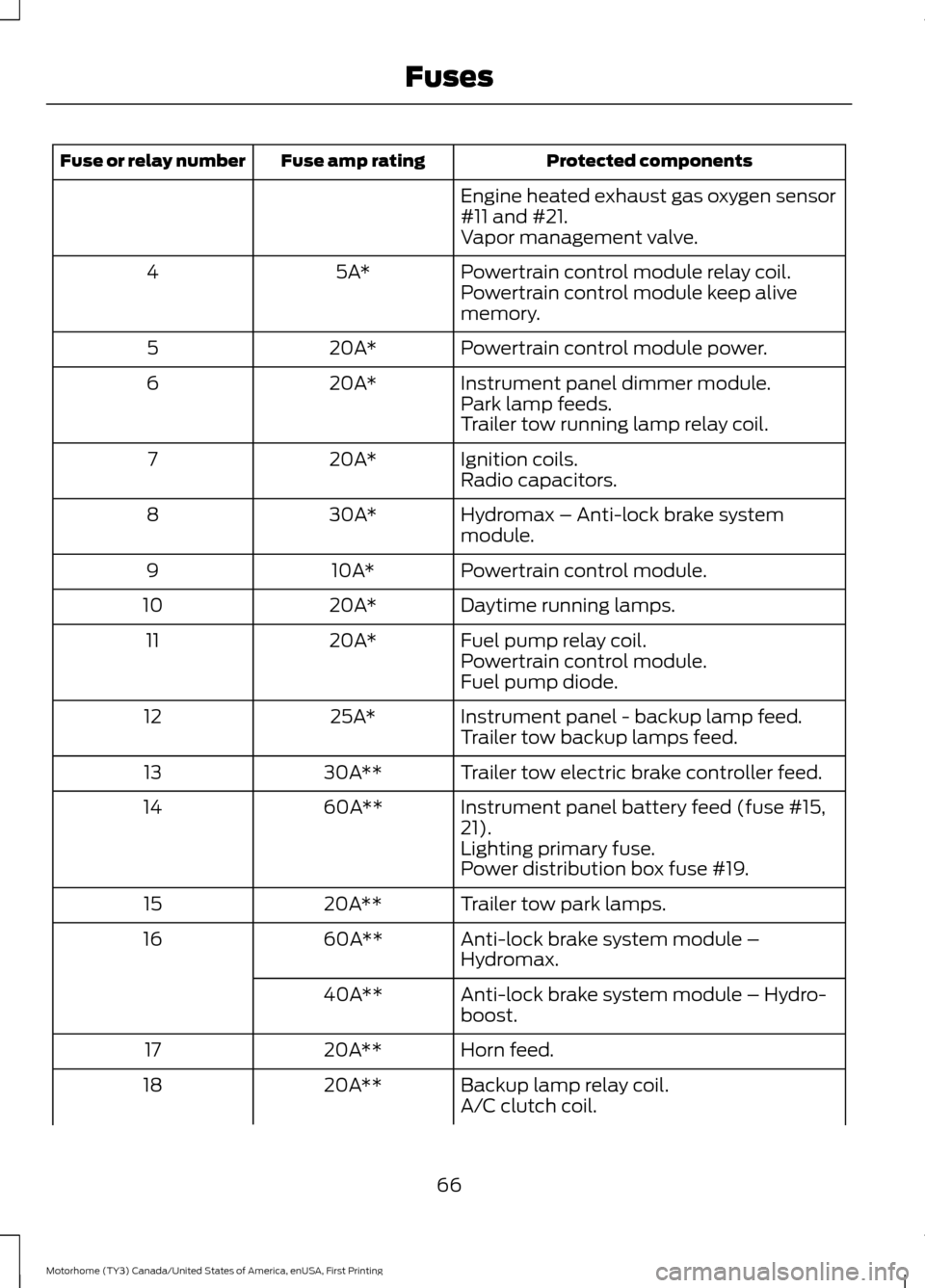
Protected components
Fuse amp rating
Fuse or relay number
Engine heated exhaust gas oxygen sensor
#11 and #21.
Vapor management valve.
Powertrain control module relay coil.
5A*
4
Powertrain control module keep alive
memory.
Powertrain control module power.
20A*
5
Instrument panel dimmer module.
20A*
6
Park lamp feeds.
Trailer tow running lamp relay coil.
Ignition coils.
20A*
7
Radio capacitors.
Hydromax – Anti-lock brake system
module.
30A*
8
Powertrain control module.
10A*
9
Daytime running lamps.
20A*
10
Fuel pump relay coil.
20A*
11
Powertrain control module.
Fuel pump diode.
Instrument panel - backup lamp feed.
25A*
12
Trailer tow backup lamps feed.
Trailer tow electric brake controller feed.
30A**
13
Instrument panel battery feed (fuse #15,
21).
60A**
14
Lighting primary fuse.
Power distribution box fuse #19.
Trailer tow park lamps.
20A**
15
Anti-lock brake system module –
Hydromax.
60A**
16
Anti-lock brake system module – Hydro-
boost.
40A**
Horn feed.
20A**
17
Backup lamp relay coil.
20A**
18
A/C clutch coil.
66
Motorhome (TY3) Canada/United States of America, enUSA, First Printing Fuses
Page 72 of 164
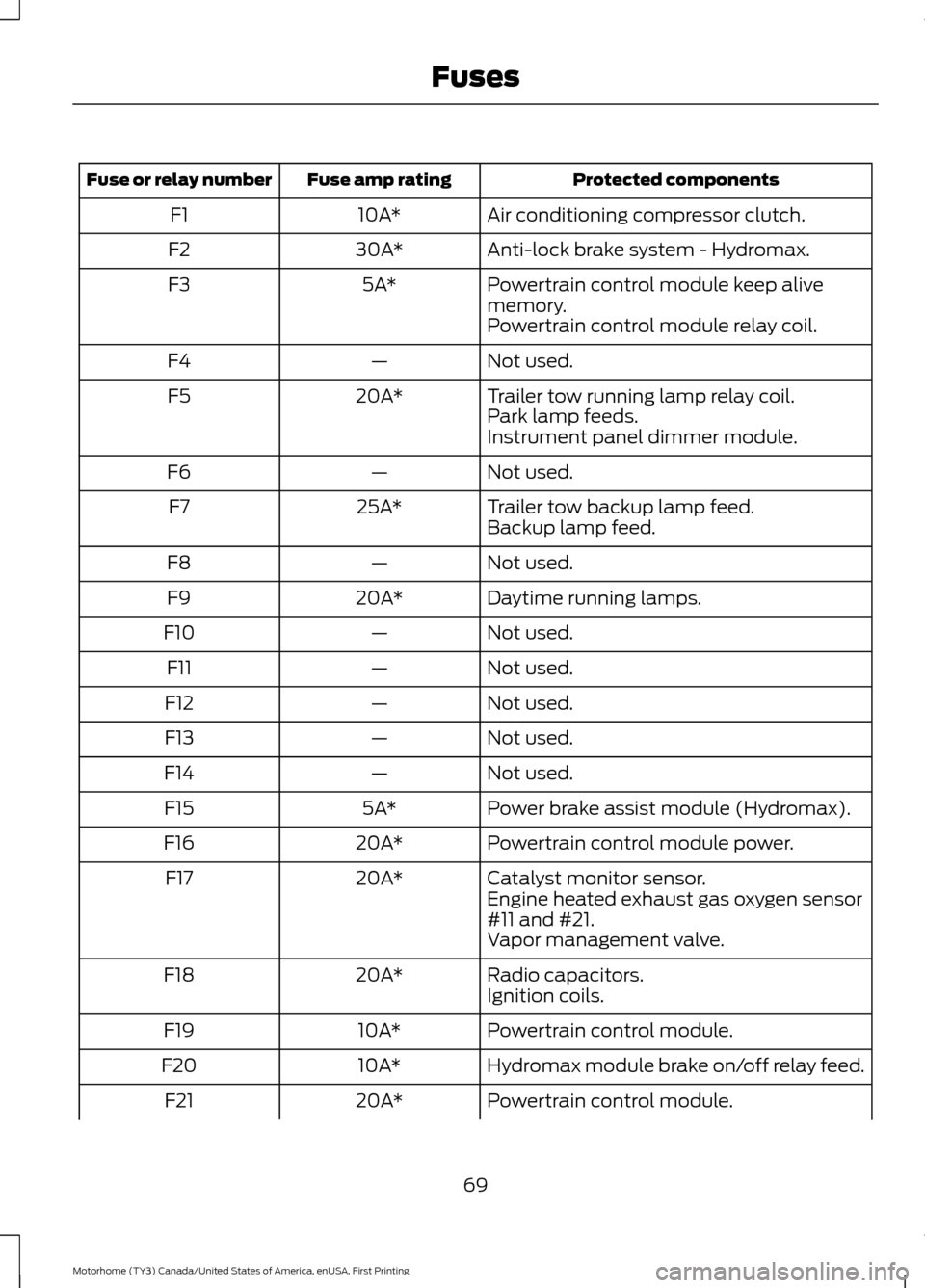
Protected components
Fuse amp rating
Fuse or relay number
Air conditioning compressor clutch.
10A*
F1
Anti-lock brake system - Hydromax.
30A*
F2
Powertrain control module keep alive
memory.
5A*
F3
Powertrain control module relay coil.
Not used.
—
F4
Trailer tow running lamp relay coil.
20A*
F5
Park lamp feeds.
Instrument panel dimmer module.
Not used.
—
F6
Trailer tow backup lamp feed.
25A*
F7
Backup lamp feed.
Not used.
—
F8
Daytime running lamps.
20A*
F9
Not used.
—
F10
Not used.
—
F11
Not used.
—
F12
Not used.
—
F13
Not used.
—
F14
Power brake assist module (Hydromax).
5A*
F15
Powertrain control module power.
20A*
F16
Catalyst monitor sensor.
20A*
F17
Engine heated exhaust gas oxygen sensor
#11 and #21.
Vapor management valve.
Radio capacitors.
20A*
F18
Ignition coils.
Powertrain control module.
10A*
F19
Hydromax module brake on/off relay feed.
10A*
F20
Powertrain control module.
20A*
F21
69
Motorhome (TY3) Canada/United States of America, enUSA, First Printing Fuses
Page 77 of 164
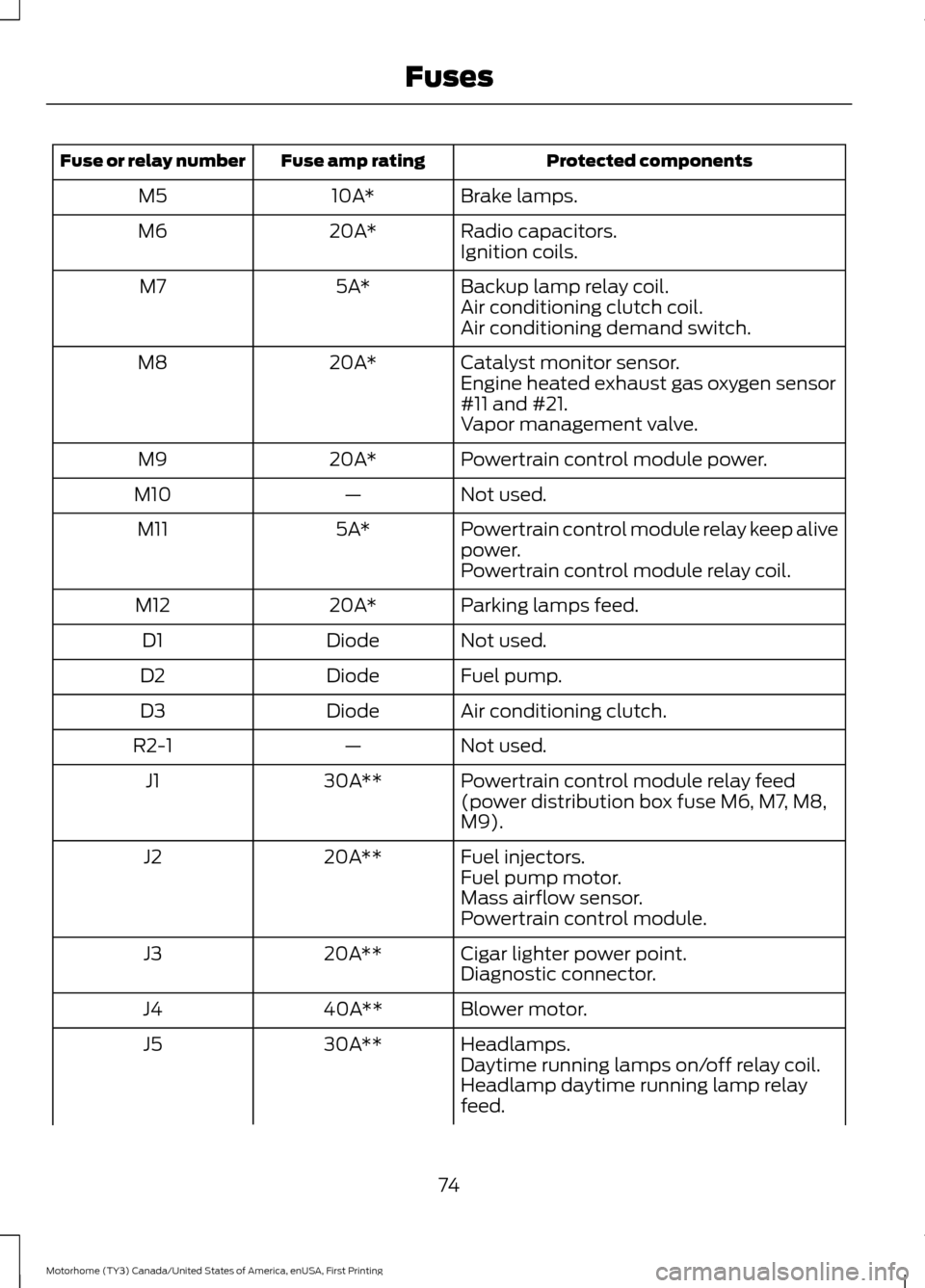
Protected components
Fuse amp rating
Fuse or relay number
Brake lamps.
10A*
M5
Radio capacitors.
20A*
M6
Ignition coils.
Backup lamp relay coil.
5A*
M7
Air conditioning clutch coil.
Air conditioning demand switch.
Catalyst monitor sensor.
20A*
M8
Engine heated exhaust gas oxygen sensor
#11 and #21.
Vapor management valve.
Powertrain control module power.
20A*
M9
Not used.
—
M10
Powertrain control module relay keep alive
power.
5A*
M11
Powertrain control module relay coil.
Parking lamps feed.
20A*
M12
Not used.
Diode
D1
Fuel pump.
Diode
D2
Air conditioning clutch.
Diode
D3
Not used.
—
R2-1
Powertrain control module relay feed
(power distribution box fuse M6, M7, M8,
M9).
30A**
J1
Fuel injectors.
20A**
J2
Fuel pump motor.
Mass airflow sensor.
Powertrain control module.
Cigar lighter power point.
20A**
J3
Diagnostic connector.
Blower motor.
40A**
J4
Headlamps.
30A**
J5
Daytime running lamps on/off relay coil.
Headlamp daytime running lamp relay
feed.
74
Motorhome (TY3) Canada/United States of America, enUSA, First Printing Fuses
Page 81 of 164
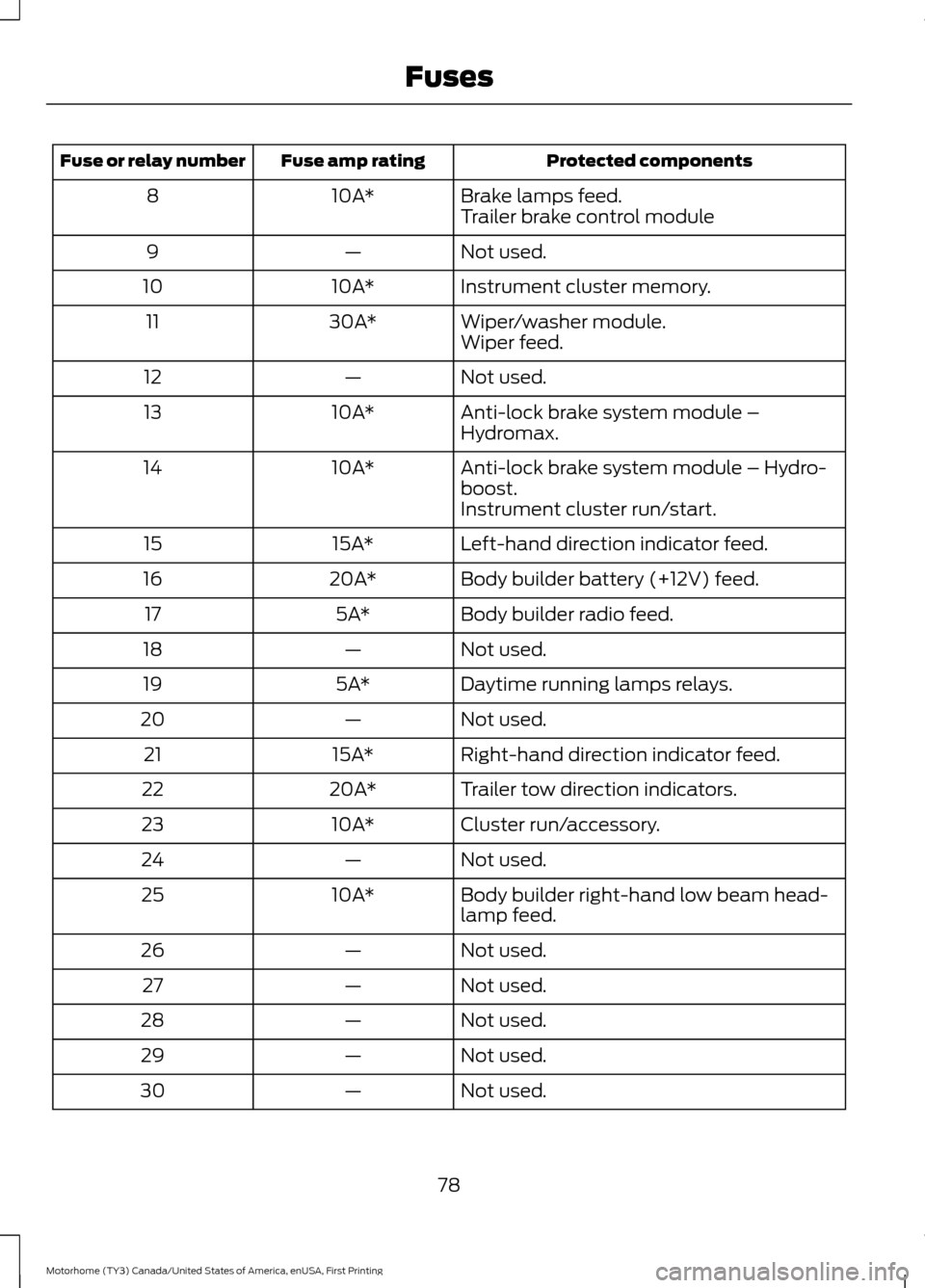
Protected components
Fuse amp rating
Fuse or relay number
Brake lamps feed.
10A*
8
Trailer brake control module
Not used.
—
9
Instrument cluster memory.
10A*
10
Wiper/washer module.
30A*
11
Wiper feed.
Not used.
—
12
Anti-lock brake system module –
Hydromax.
10A*
13
Anti-lock brake system module – Hydro-
boost.
10A*
14
Instrument cluster run/start.
Left-hand direction indicator feed.
15A*
15
Body builder battery (+12V) feed.
20A*
16
Body builder radio feed.
5A*
17
Not used.
—
18
Daytime running lamps relays.
5A*
19
Not used.
—
20
Right-hand direction indicator feed.
15A*
21
Trailer tow direction indicators.
20A*
22
Cluster run/accessory.
10A*
23
Not used.
—
24
Body builder right-hand low beam head-
lamp feed.
10A*
25
Not used.
—
26
Not used.
—
27
Not used.
—
28
Not used.
—
29
Not used.
—
30
78
Motorhome (TY3) Canada/United States of America, enUSA, First Printing Fuses
Page 85 of 164
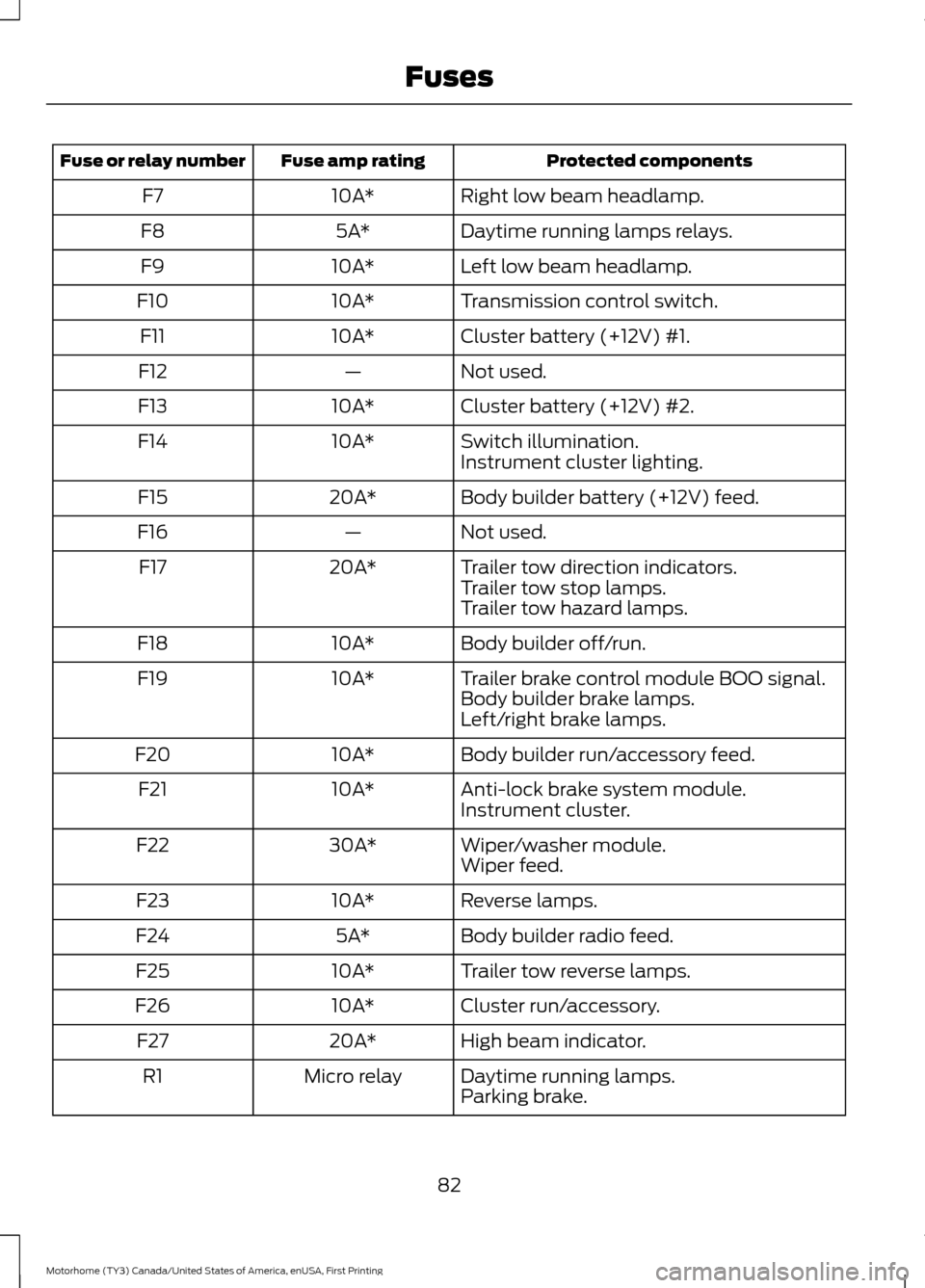
Protected components
Fuse amp rating
Fuse or relay number
Right low beam headlamp.
10A*
F7
Daytime running lamps relays.
5A*
F8
Left low beam headlamp.
10A*
F9
Transmission control switch.
10A*
F10
Cluster battery (+12V) #1.
10A*
F11
Not used.
—
F12
Cluster battery (+12V) #2.
10A*
F13
Switch illumination.
10A*
F14
Instrument cluster lighting.
Body builder battery (+12V) feed.
20A*
F15
Not used.
—
F16
Trailer tow direction indicators.
20A*
F17
Trailer tow stop lamps.
Trailer tow hazard lamps.
Body builder off/run.
10A*
F18
Trailer brake control module BOO signal.
10A*
F19
Body builder brake lamps.
Left/right brake lamps.
Body builder run/accessory feed.
10A*
F20
Anti-lock brake system module.
10A*
F21
Instrument cluster.
Wiper/washer module.
30A*
F22
Wiper feed.
Reverse lamps.
10A*
F23
Body builder radio feed.
5A*
F24
Trailer tow reverse lamps.
10A*
F25
Cluster run/accessory.
10A*
F26
High beam indicator.
20A*
F27
Daytime running lamps.
Micro relay
R1
Parking brake.
82
Motorhome (TY3) Canada/United States of America, enUSA, First Printing Fuses
Page 102 of 164
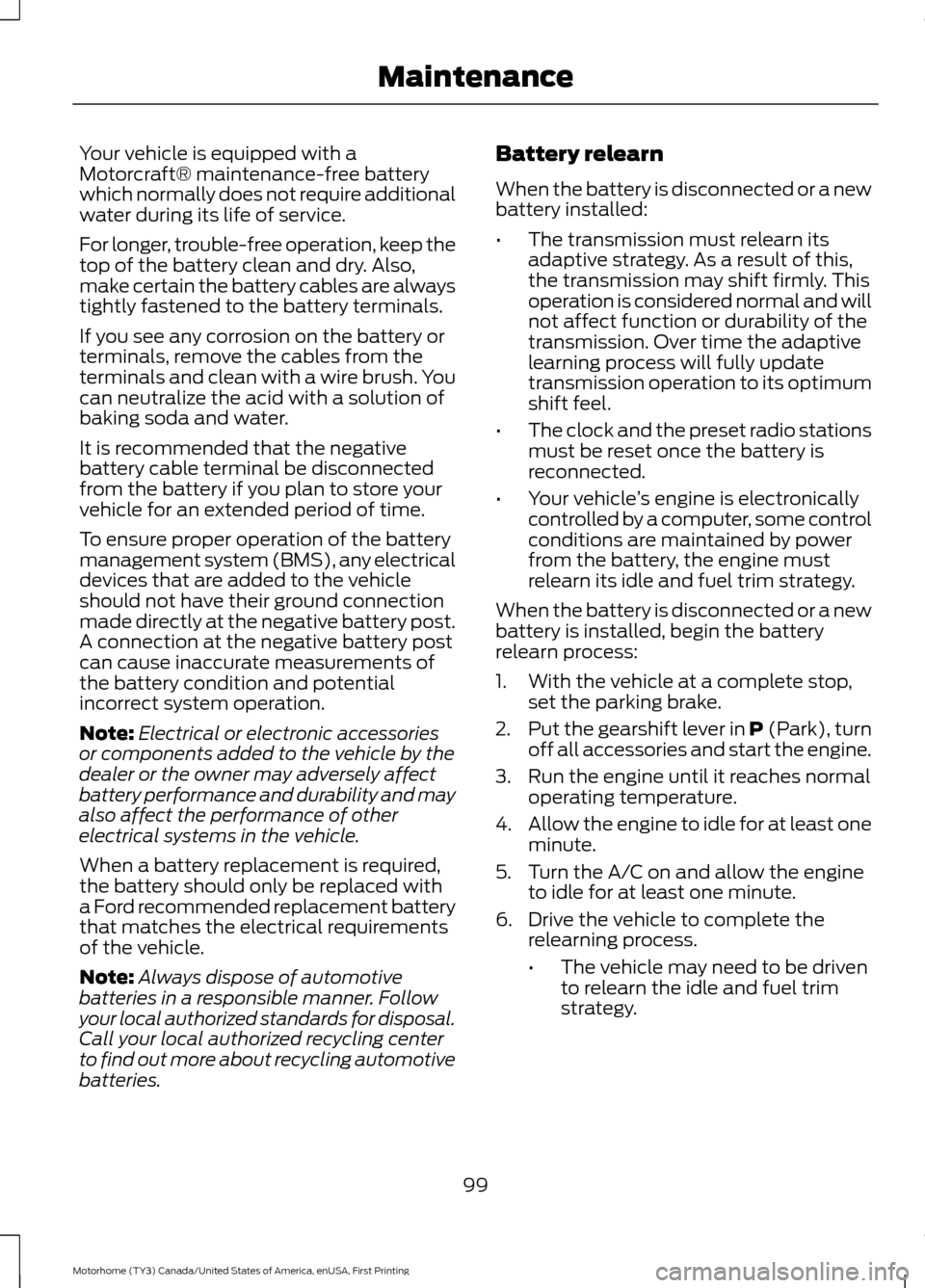
Your vehicle is equipped with a
Motorcraft® maintenance-free battery
which normally does not require additional
water during its life of service.
For longer, trouble-free operation, keep the
top of the battery clean and dry. Also,
make certain the battery cables are always
tightly fastened to the battery terminals.
If you see any corrosion on the battery or
terminals, remove the cables from the
terminals and clean with a wire brush. You
can neutralize the acid with a solution of
baking soda and water.
It is recommended that the negative
battery cable terminal be disconnected
from the battery if you plan to store your
vehicle for an extended period of time.
To ensure proper operation of the battery
management system (BMS), any electrical
devices that are added to the vehicle
should not have their ground connection
made directly at the negative battery post.
A connection at the negative battery post
can cause inaccurate measurements of
the battery condition and potential
incorrect system operation.
Note:
Electrical or electronic accessories
or components added to the vehicle by the
dealer or the owner may adversely affect
battery performance and durability and may
also affect the performance of other
electrical systems in the vehicle.
When a battery replacement is required,
the battery should only be replaced with
a Ford recommended replacement battery
that matches the electrical requirements
of the vehicle.
Note: Always dispose of automotive
batteries in a responsible manner. Follow
your local authorized standards for disposal.
Call your local authorized recycling center
to find out more about recycling automotive
batteries. Battery relearn
When the battery is disconnected or a new
battery installed:
•
The transmission must relearn its
adaptive strategy. As a result of this,
the transmission may shift firmly. This
operation is considered normal and will
not affect function or durability of the
transmission. Over time the adaptive
learning process will fully update
transmission operation to its optimum
shift feel.
• The clock and the preset radio stations
must be reset once the battery is
reconnected.
• Your vehicle ’s engine is electronically
controlled by a computer, some control
conditions are maintained by power
from the battery, the engine must
relearn its idle and fuel trim strategy.
When the battery is disconnected or a new
battery is installed, begin the battery
relearn process:
1. With the vehicle at a complete stop, set the parking brake.
2. Put the gearshift lever in P (Park), turn
off all accessories and start the engine.
3. Run the engine until it reaches normal operating temperature.
4. Allow the engine to idle for at least one
minute.
5. Turn the A/C on and allow the engine to idle for at least one minute.
6. Drive the vehicle to complete the relearning process.
•The vehicle may need to be driven
to relearn the idle and fuel trim
strategy.
99
Motorhome (TY3) Canada/United States of America, enUSA, First Printing Maintenance